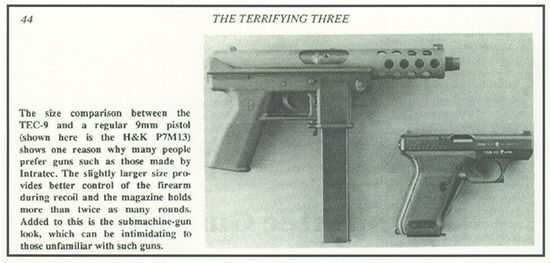Most of the assault weapons sold on America’s civilian market are semiautomatic descendants of the STG-44. Here are a few of the more popular and notorious.
Kalashnikov AK-47 and its variants. The Soviet Army’s AK-47 was derived from the STG-44 shortly after the Second World War, boosted by material and personnel that fell into Soviet hands when the Red Army overran German research and engineering facilities.12 The AK-47 (in many variants, like the AKM) has become, since the 1940s, the most widely-distributed rifle in the world.13 According to The Gun Digest Book of Assault Weapons:
“The AKM was the revolutionary weapon of the 1960s and ’70s, used by everyone from the Viet Cong to the Palestine Liberation fighters. Its comparatively short length and light weight made war more available to Third World women and children, probably not an advance for civilization.”14

AK-47, foreground, AKM, upper right background.
China exported few guns to the United States before the 1980s. But, beginning in 1987, Chinese rifle imports—mostly semi-automatic versions of the AK-47—surged. The flood of Chinese rifles reached 64 percent of all rifles imported into the United States in 1993 and was only cut off by the administration of former President Bill Clinton. (See table below.)15

AR-15 Variant of the M-16. The U.S. Army’s decision in the 1960s to replace its M-14 battle rifle with the M-16 assault rifle was based on reasoning similar to the German army’s and highly revealing of the function of assault weapons. After studying over three million casualty reports from World Wars I and II, and data from the Korean War, the Army’s Operations Research Office (ORO) found that, “in the overall picture, aimed fire did not seem to have any more important role in creating casualties than randomly fired shots. Marksmanship was not as important as volume. Fire was seldom effectively used beyond 300 meters due to terrain…and [ORO] discovered that most kills occur at 100 meters or less. From this data, ORO concluded that what the Army needed was a low recoil weapon firing a number of small projectiles….The [Armalite] AR-15 was chosen as the best small caliber weapon and it was adopted as the M16.”16

The U.S. Army adopted the M-16 assault rifle in the 1960s. It saw extensive service during the Vietnam War.
Another expert’s explanation of the Army’s reasoning sheds light on one of the principal dangers of assault weapons on civilian streets—”spray and pray” firing:
The studies showed that…in spite of the huge amounts of money spent by the military services in training combat infantrymen to be marksmen, few were capable of firing effectively beyond ranges of 200 to 300 meters in the heat of battle. “Spray and pray” would come to be the practice on the future battlefields of Vietnam.17

Books like these two illustrate that there is virtually no difference between the military M-16 and the civilian AR-15, the latter being only slightly modified for sale in the civilian market. The titles themselves show the popular equivalence.

The gun industry was quick to begin churning out civilian versions of the M-16, labeling the semiautomatic models the “AR-15,” not coincidentally the same name as the prototype version of the military assault rifle.

Bushmaster’s version of the AR-15 achieved new heights of notoriety in 2002 when it was revealed that one model was the weapon used by the infamous Washington, DC-area snipers.
Assault Pistols—UZI, Ingram, Intratec, and More. A particularly deadly variant in the gun industry’s marketing program has been the sale of civilian assault pistols, which are for the most part simply semiautomatic versions of submachine guns. Firearms expert Duncan Long explained the marketing basis of this trend in his book The Terrifying Three: Uzi, Ingram, and Intratec Weapons Families:
As the militaries of the world increasingly rely on assault rifles to fill the submachine gun role, making money on a new submachine gun design becomes harder and harder. Consequently, a number of companies have tried to capture the police and civilian markets….Citizens purchasing firearms for everything from plinking to self-defense have provided a lucrative market, especially in the United States. Those weapons produced for the civilian market are generally semiauto versions of the automatic weapons, often modified slightly to conform to U.S. firearms laws.18


Lagging sales to the military spurred the gun industry to market to civilians semiautomatic versions of assault pistols such as the UZI and Ingram MAC series. Assault pistols like these quickly became the preferred weapon for criminal gangs, fringe groups like militias, and mass murderers.

Firearms expert Duncan Long has succinctly summarized the perverse attractions of semiautomatic assault pistols like the Intratec TEC-9 shown above. (Image and caption from Duncan Long, The Terrifying Three.)19






